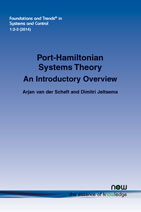Port-Hamiltonian Systems Theory: An Introductory Overview
By Arjan van der Schaft, Johann Bernoulli Institute for Mathematics and Computer Science, University of Groningen, The Netherlands, a.j.van.der.schaft@rug.nl | Dimitri Jeltsema, Delft Institute of Applied Mathematics, Delft University of Technology, The Netherlands, d.jeltsema@tudelft.nl
Abstract
An up-to-date survey of the theory of port-Hamiltonian systems is given, emphasizing novel developments and relationships with other formalisms. Port-Hamiltonian systems theory yields a systematic framework for network modeling of multi-physics systems. Examples from different areas show the range of applicability. While the emphasis is on modeling and analysis, the last part provides a brief introduction to control of port-Hamiltonian systems.
Port-Hamiltonian Systems Theory
Apart from offering a systematic and insightful framework for modeling and analysis of multi-physics systems, port-Hamiltonian systems theory provides a natural starting point for control. Especially in the nonlinear case it is widely recognized that physical properties of the system - such as balance and conservation laws and energy considerations - should be exploited and respected in the design of control laws which are robust and physically interpretable.
Port-Hamiltonian Systems Theory: An Introductory Overview provides a concise and easily accessible description of the foundations underpinning the subject, and goes on to emphasize novel developments in the field that will be of interest to a broad range of researchers. The tutorial style makes it suitable for use in a course and by students.
